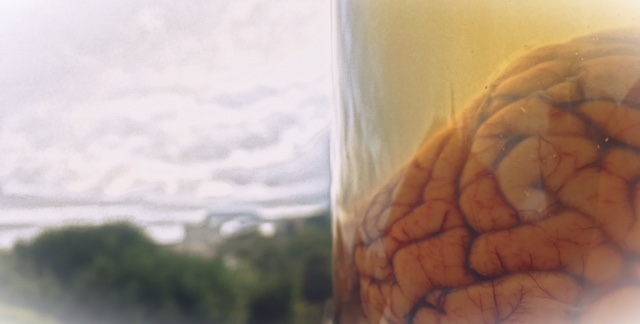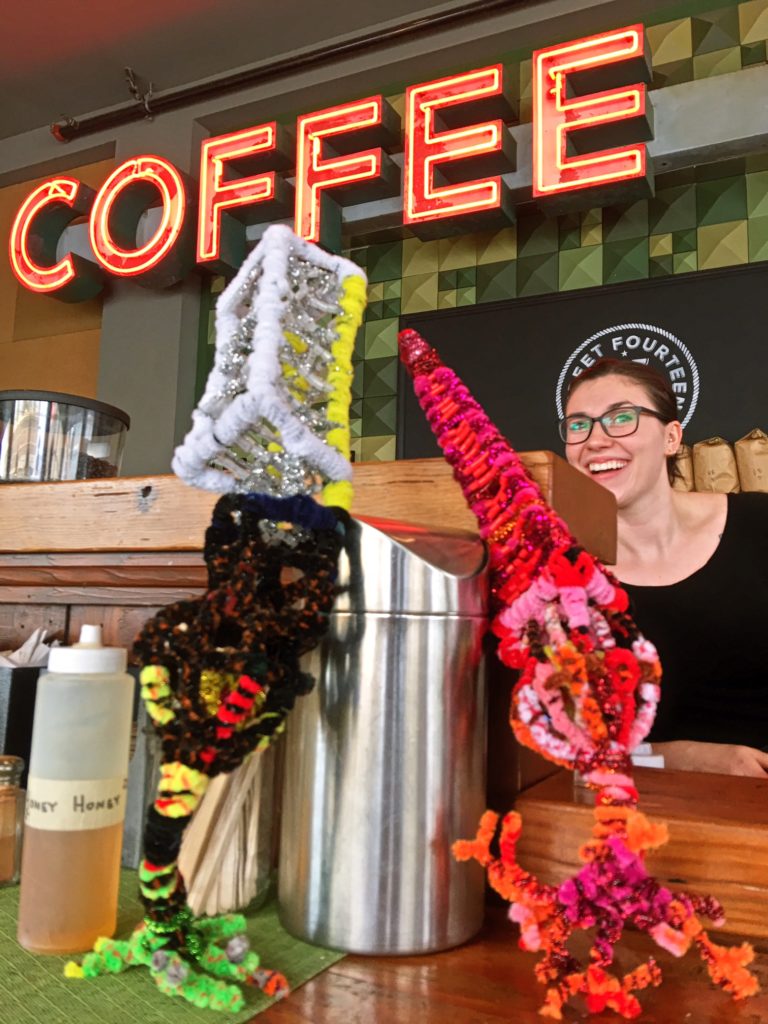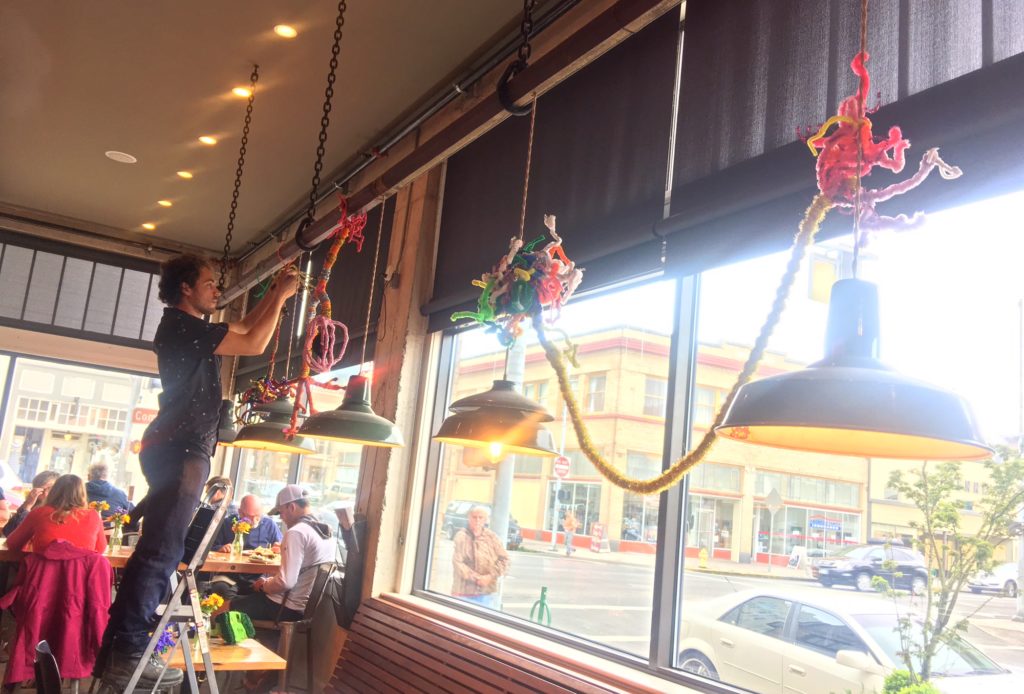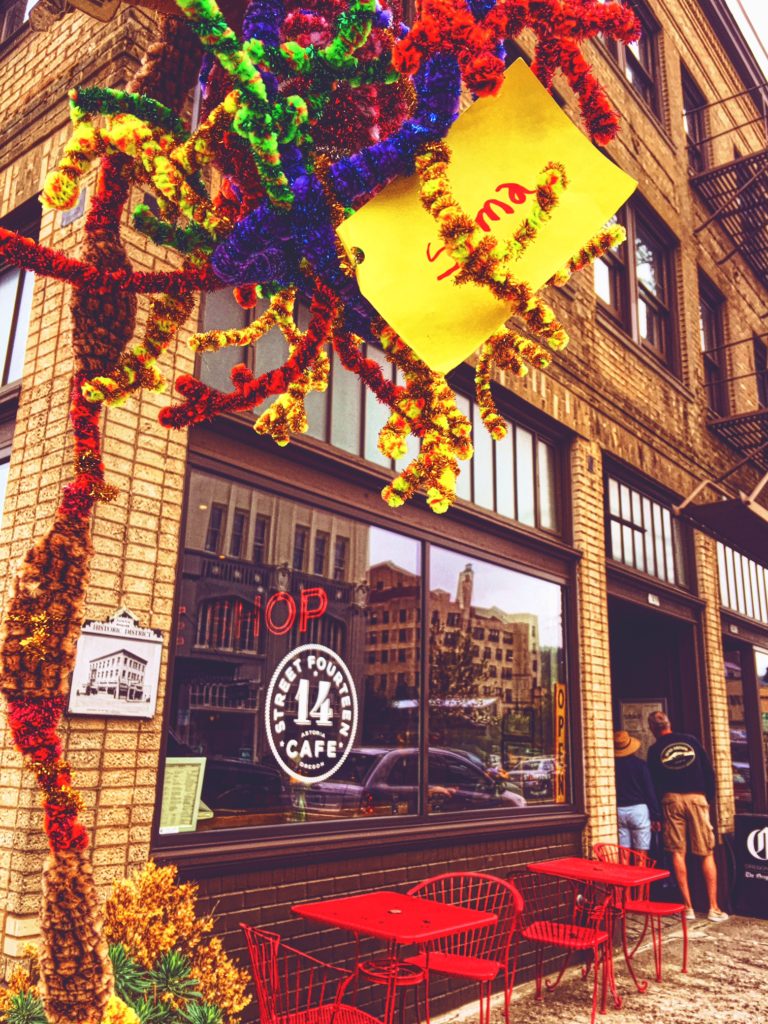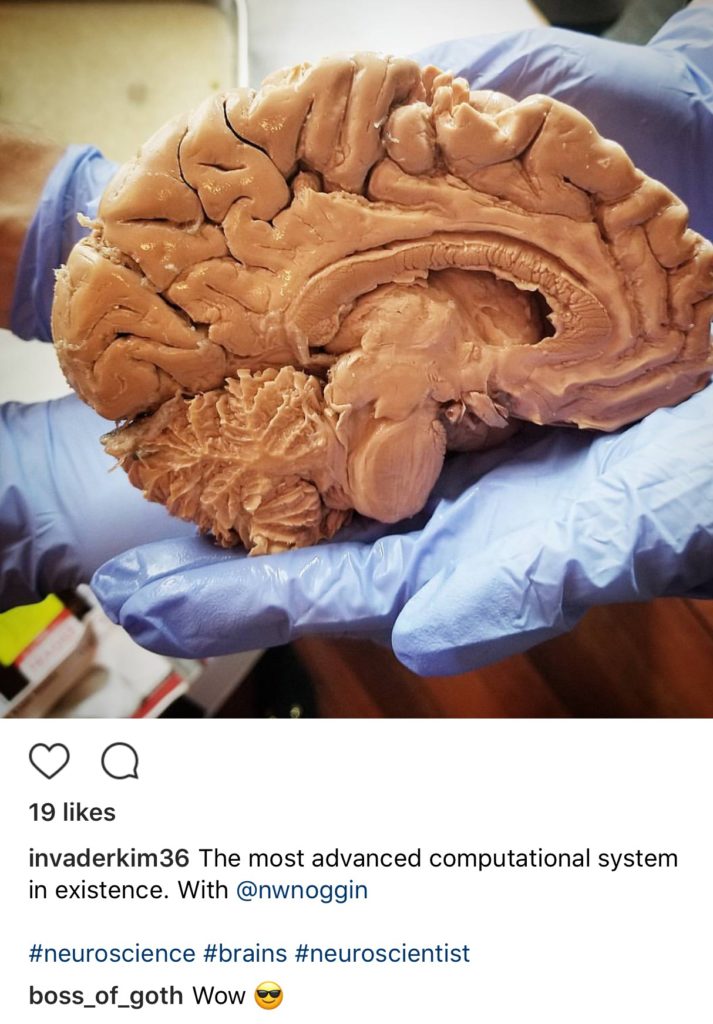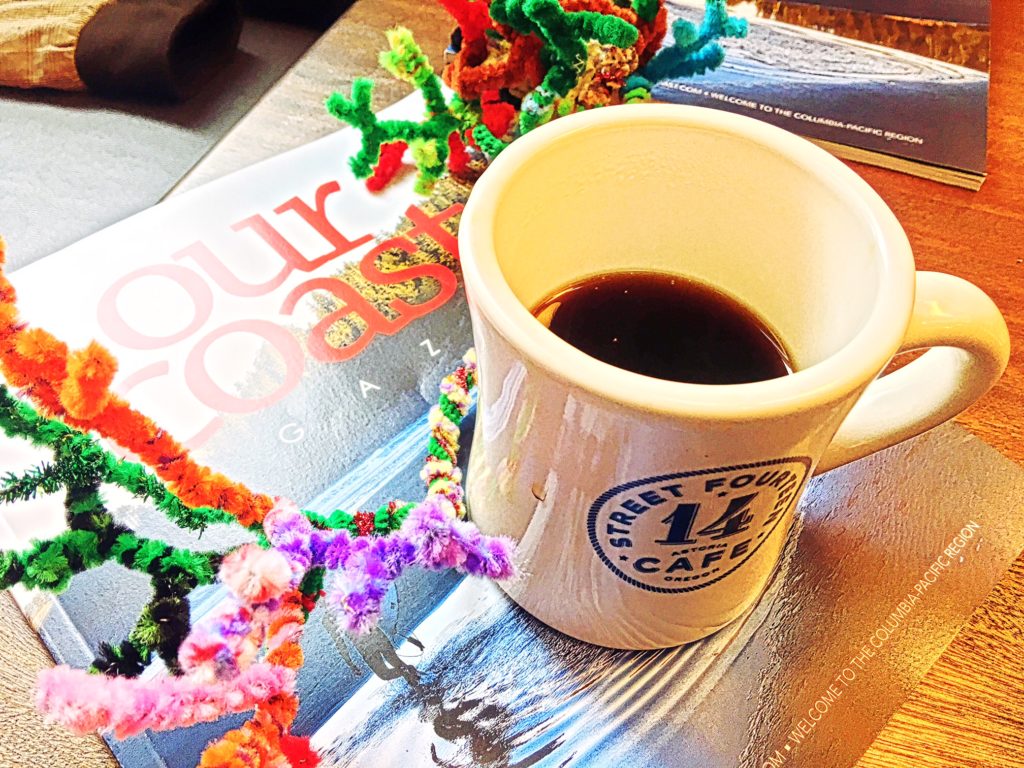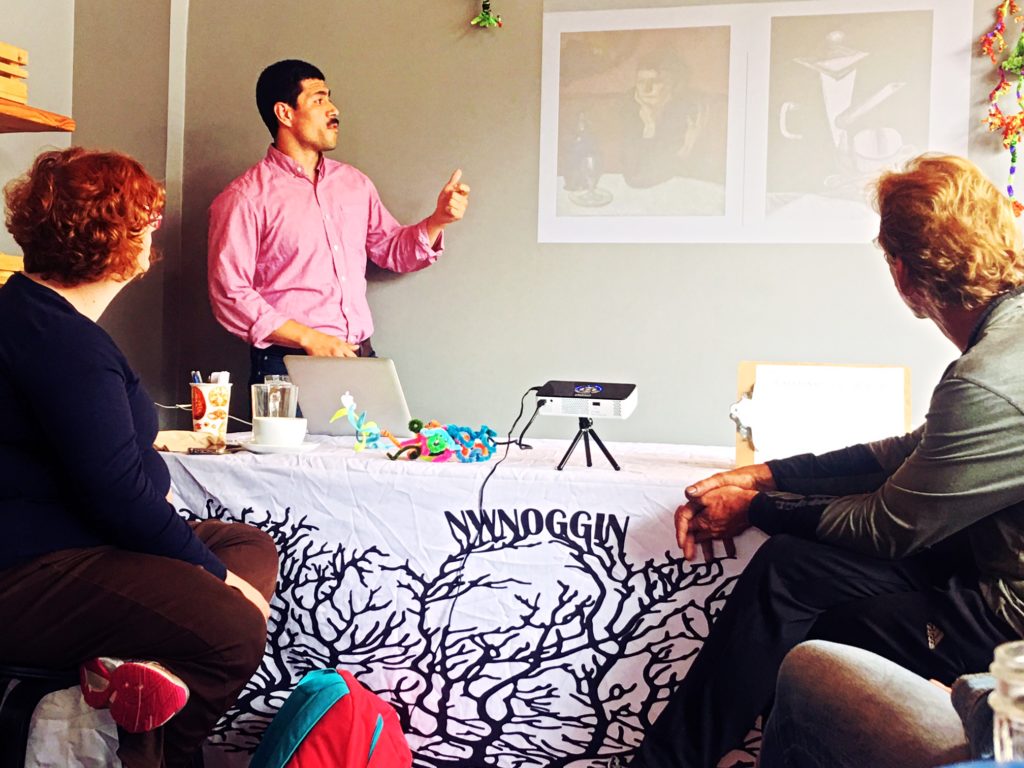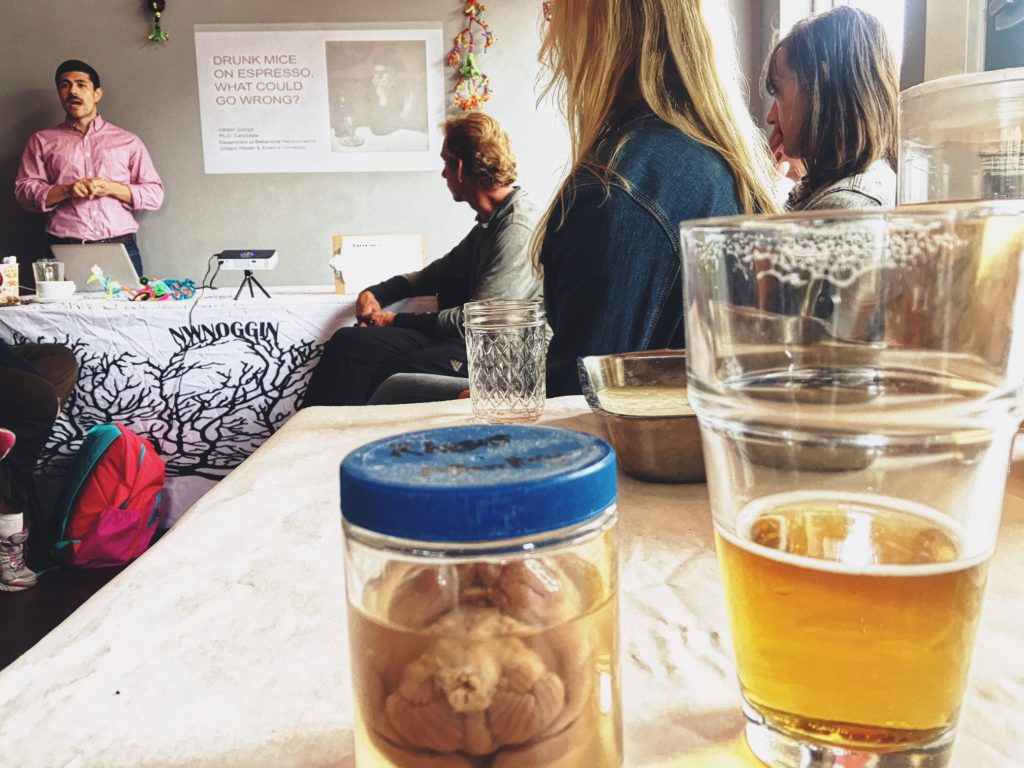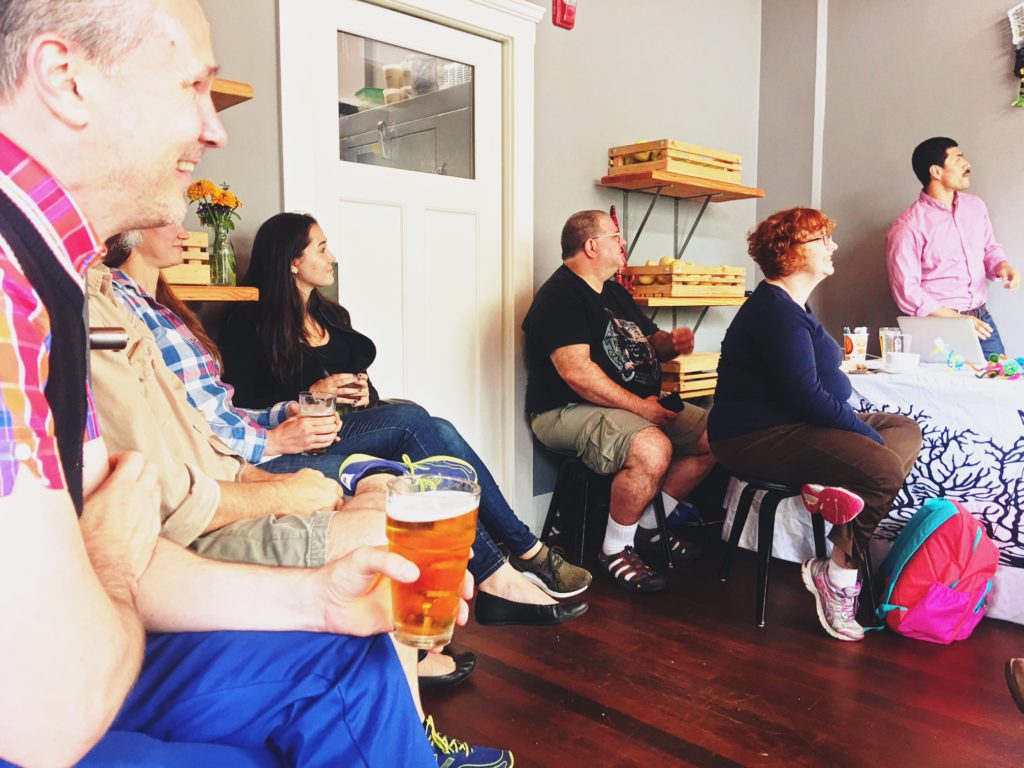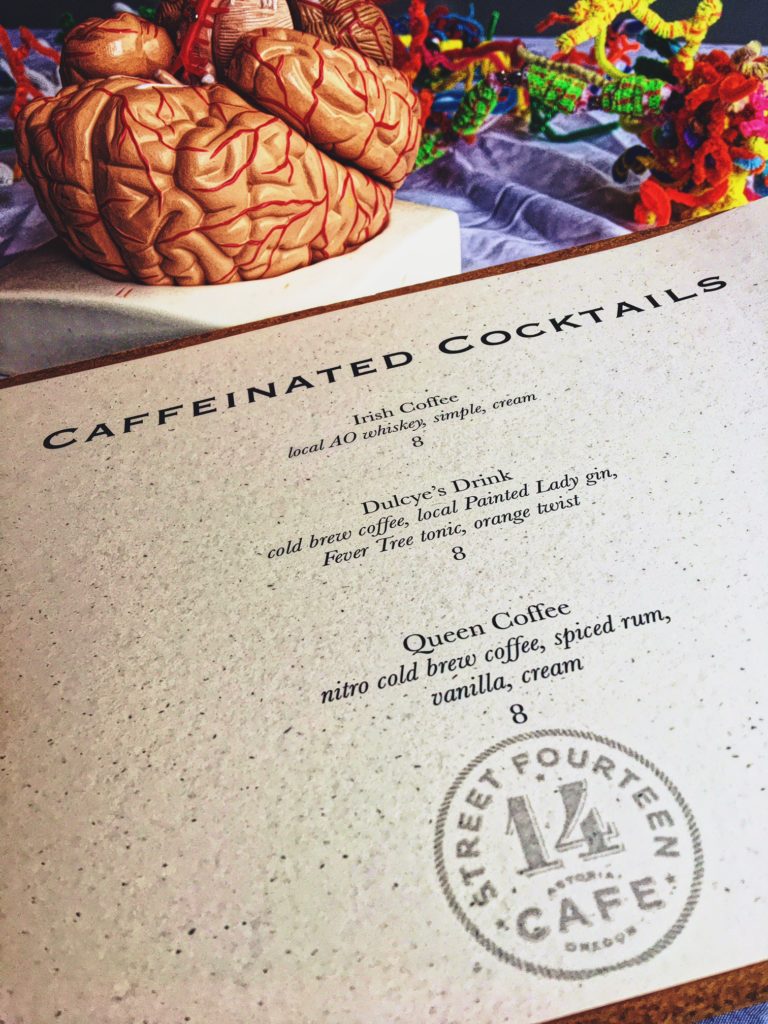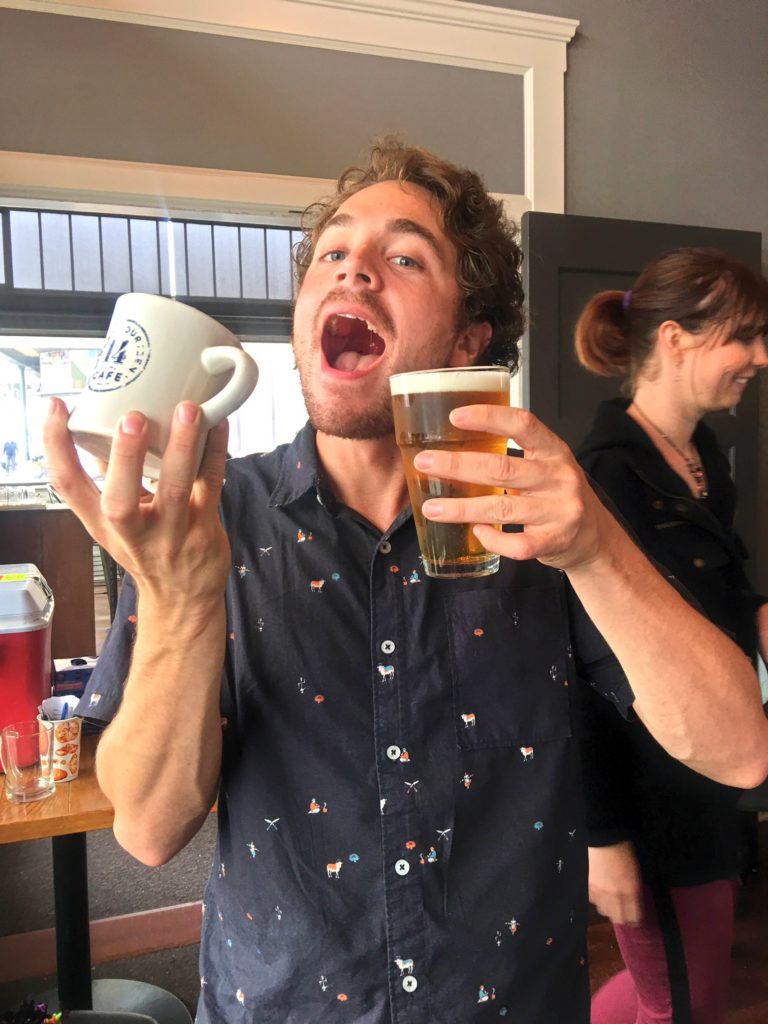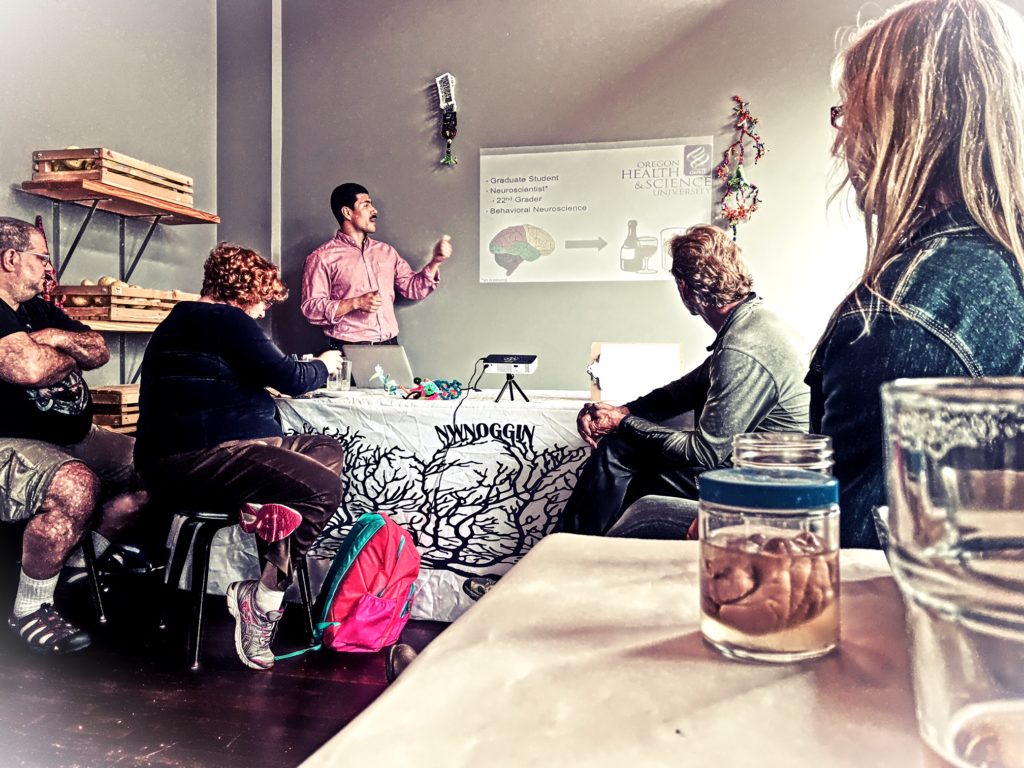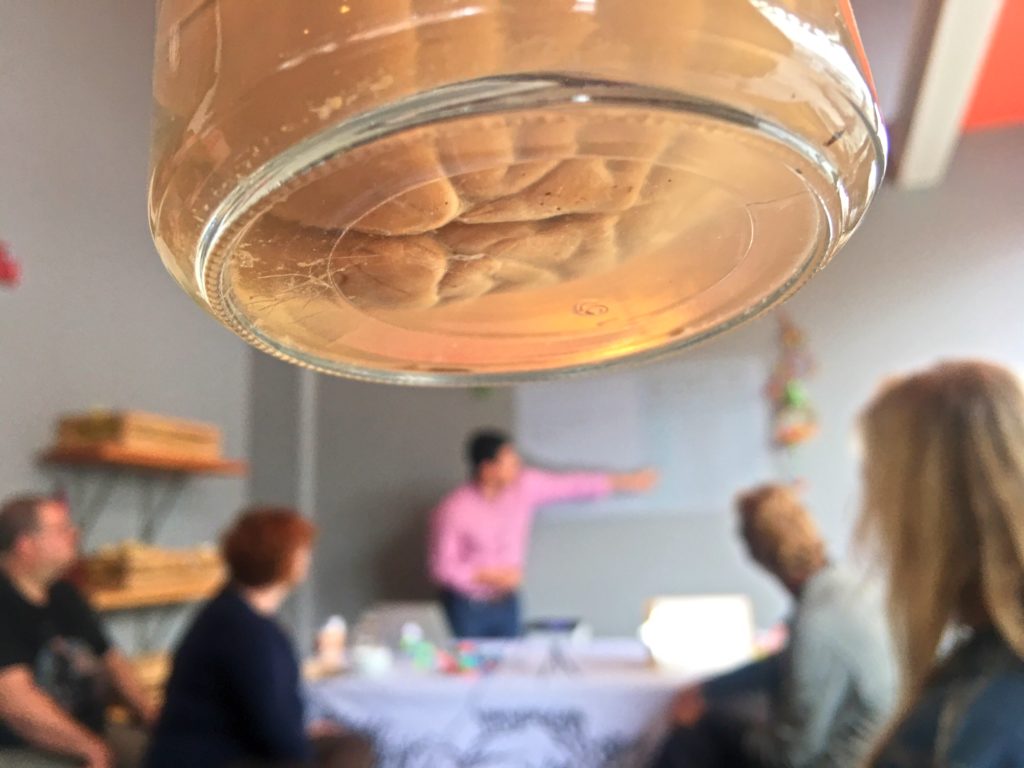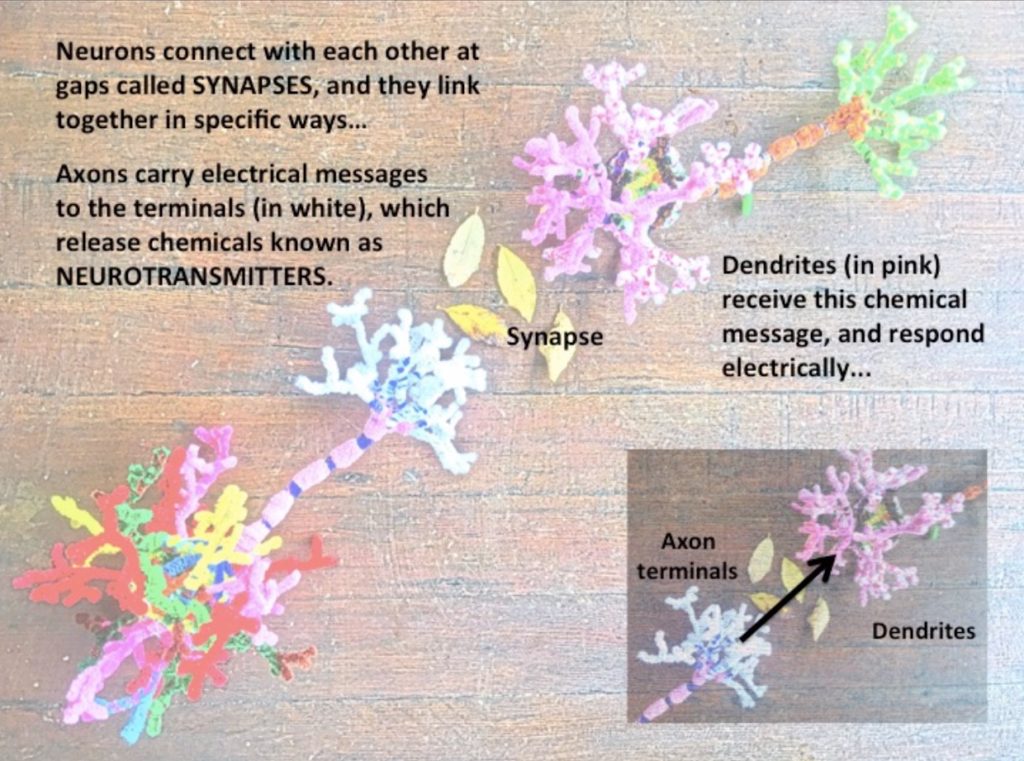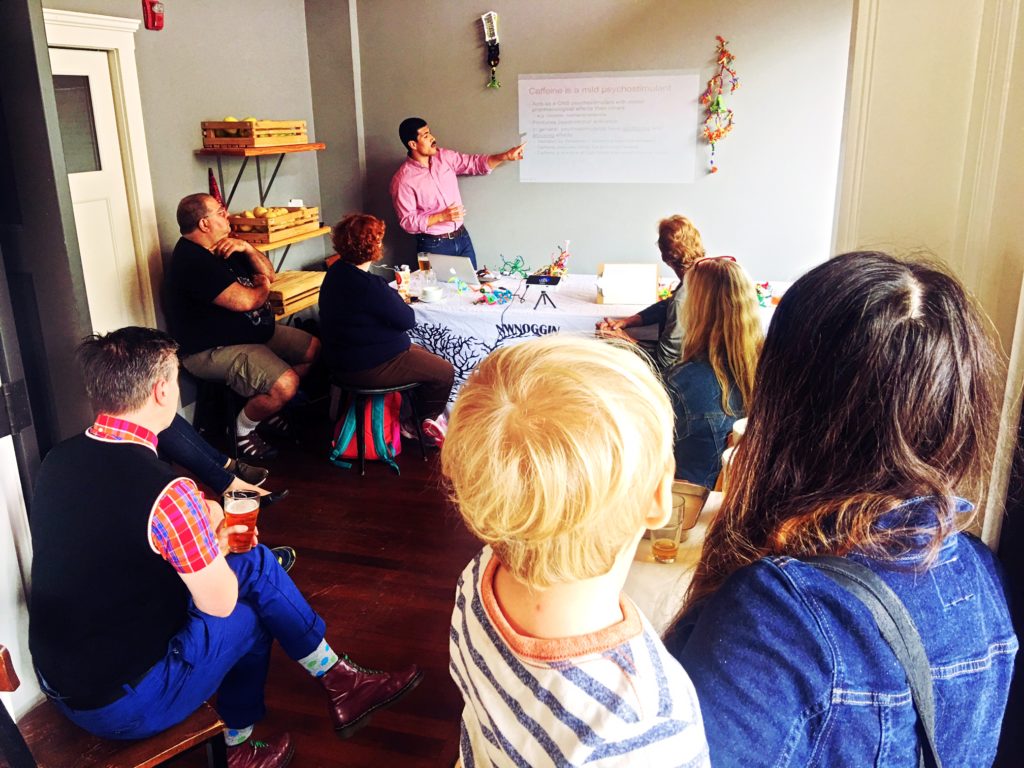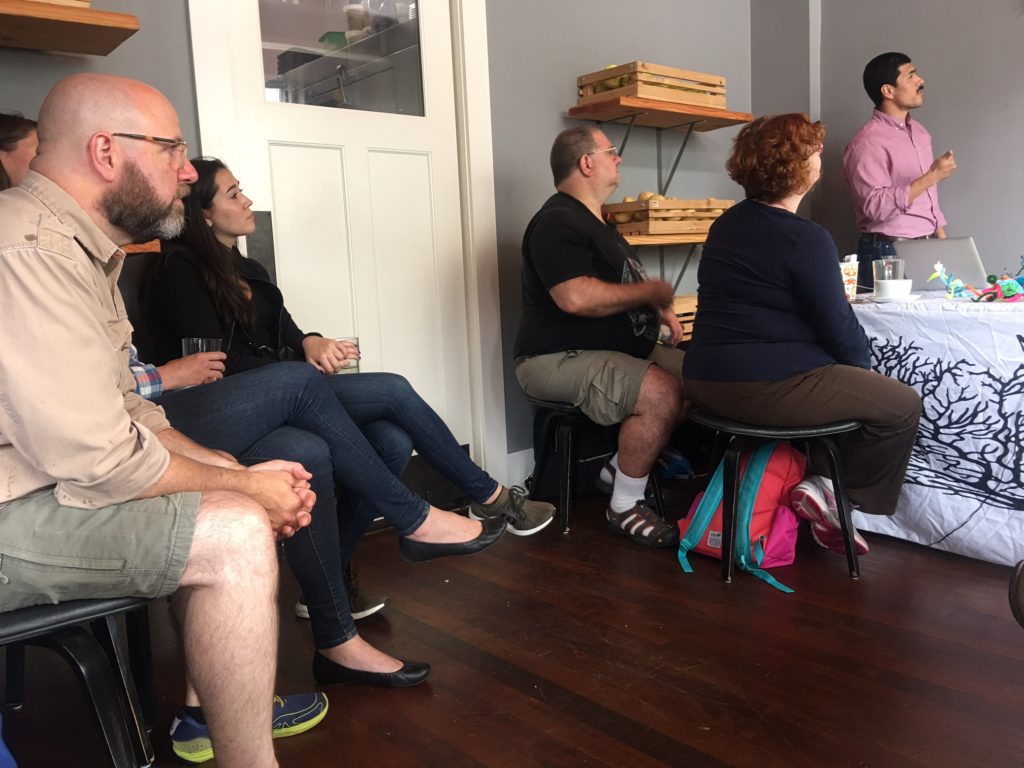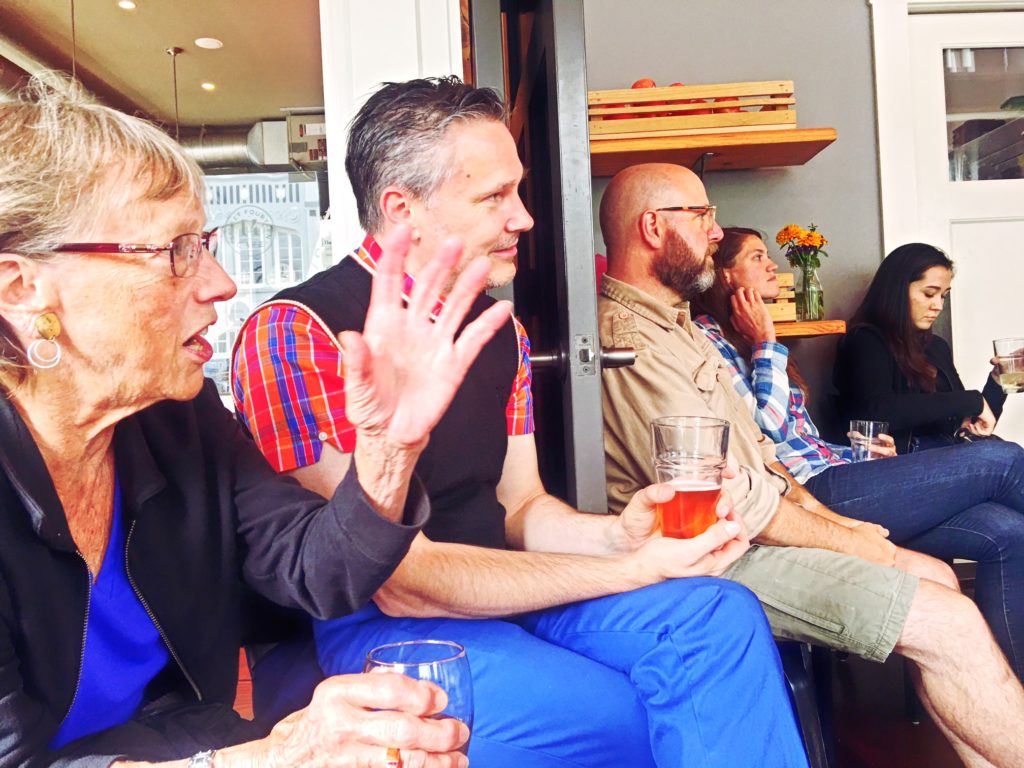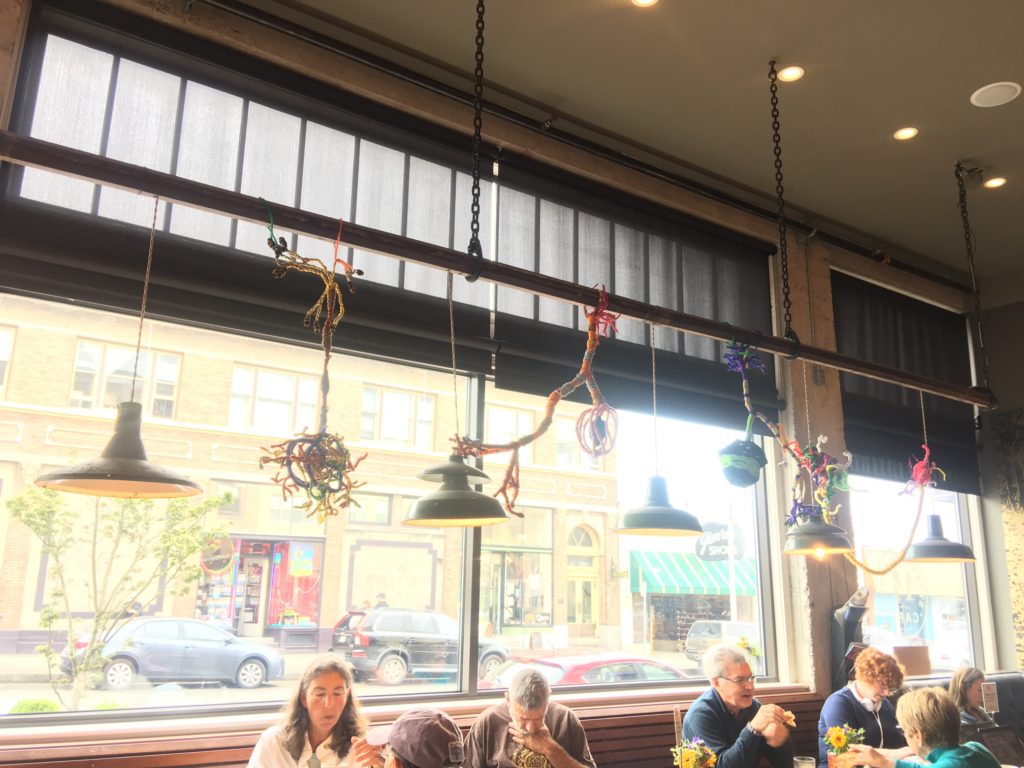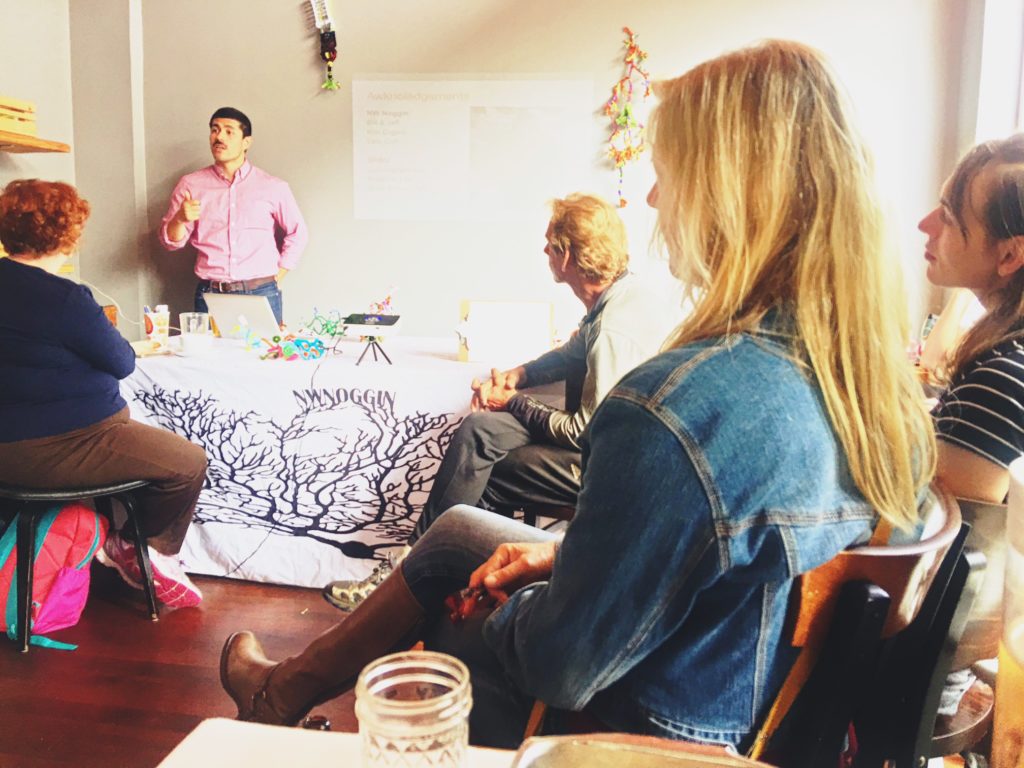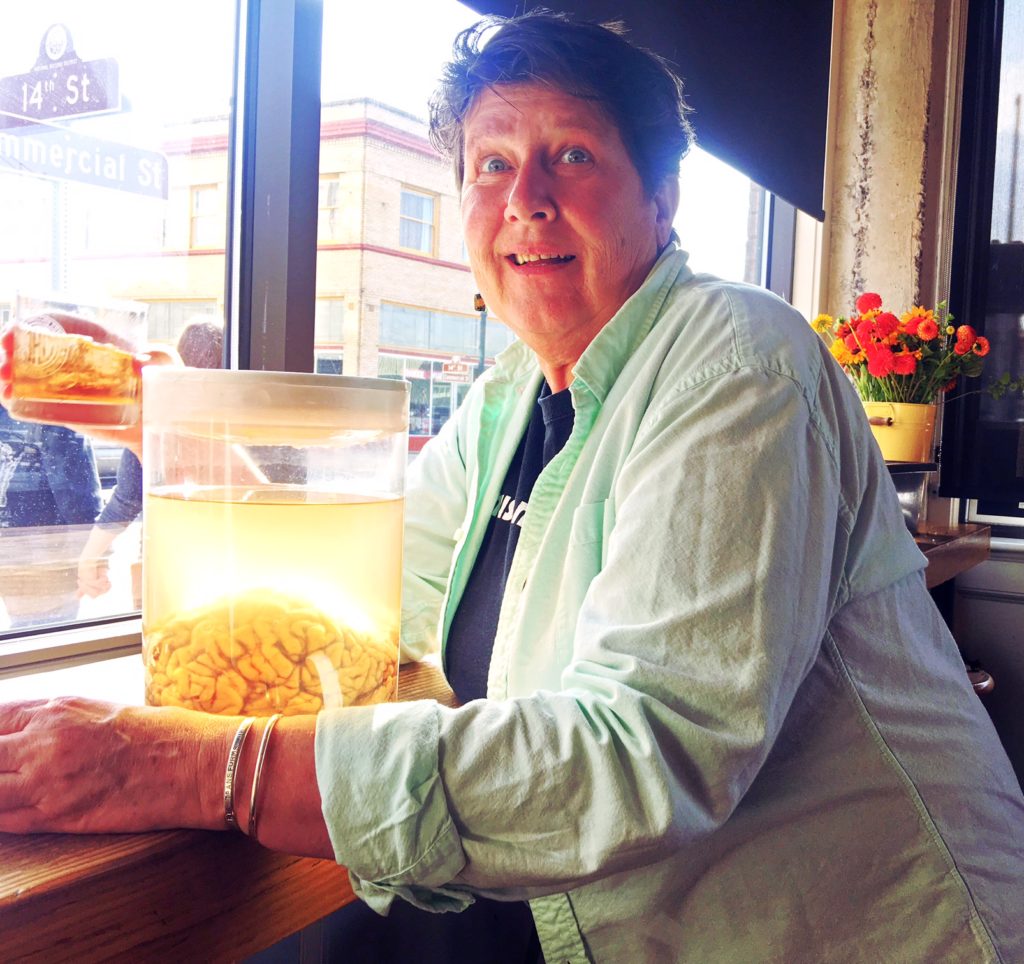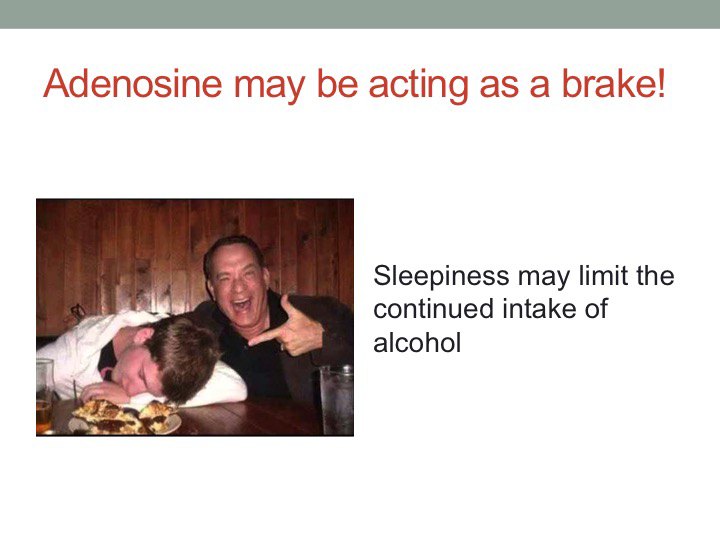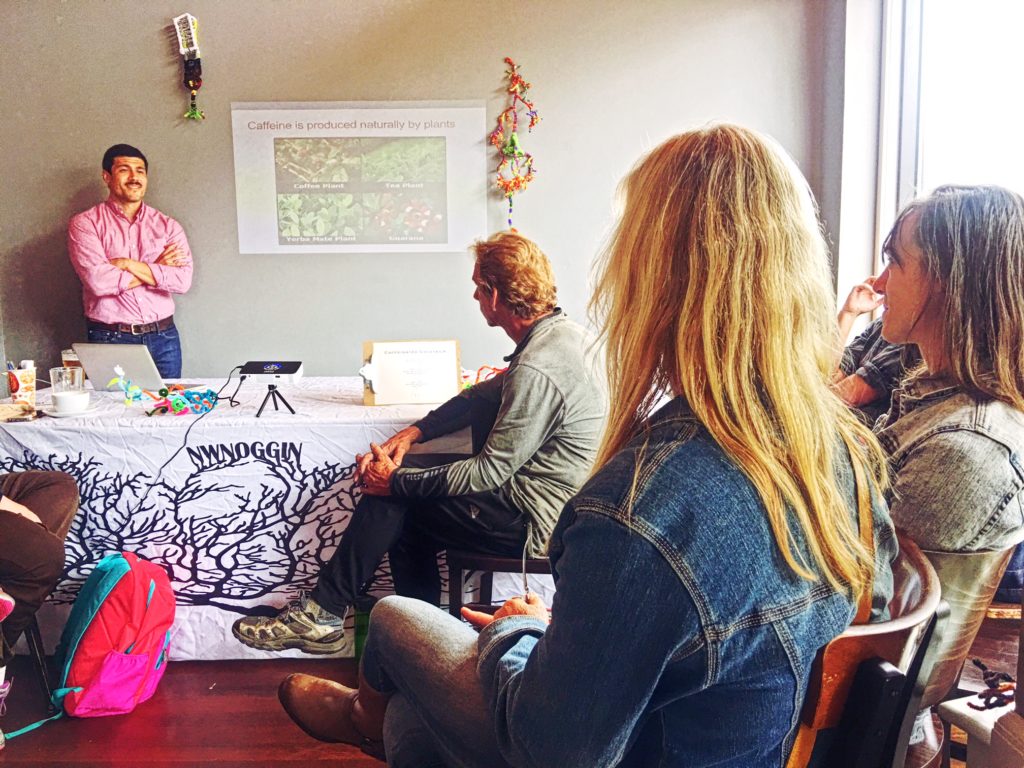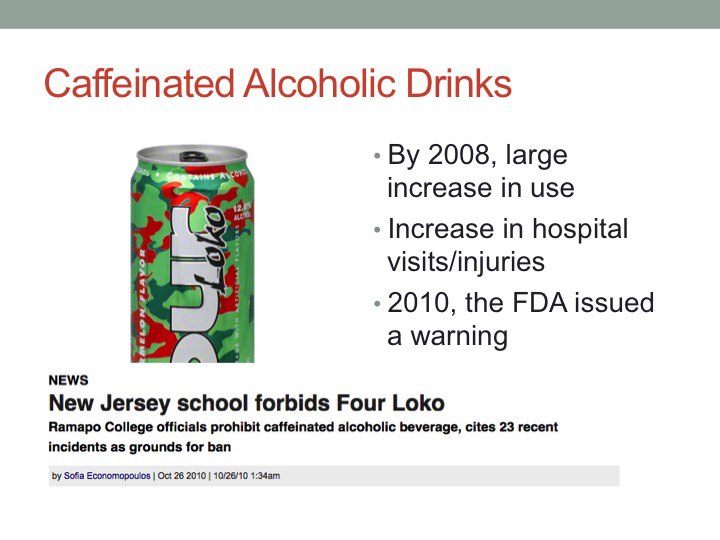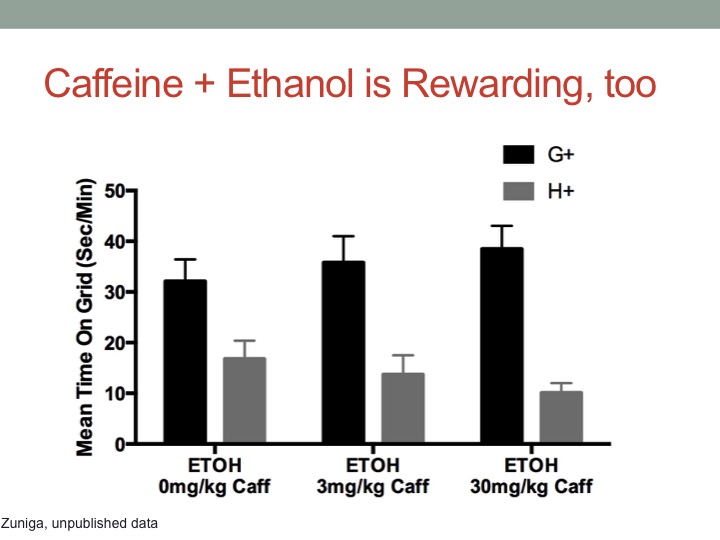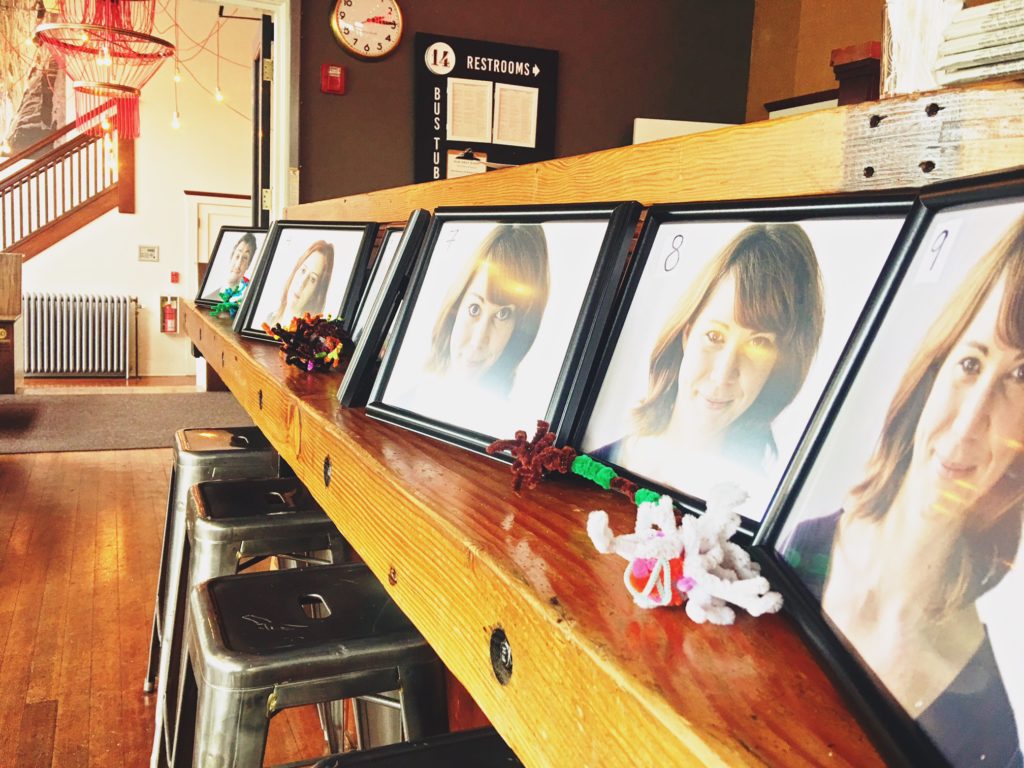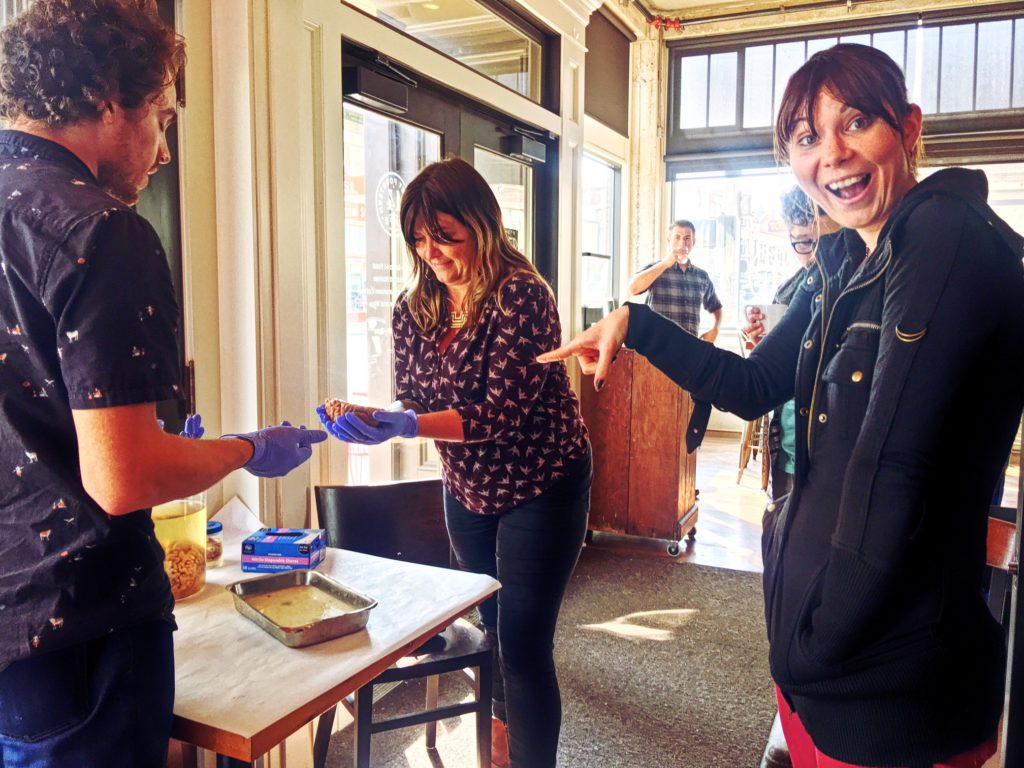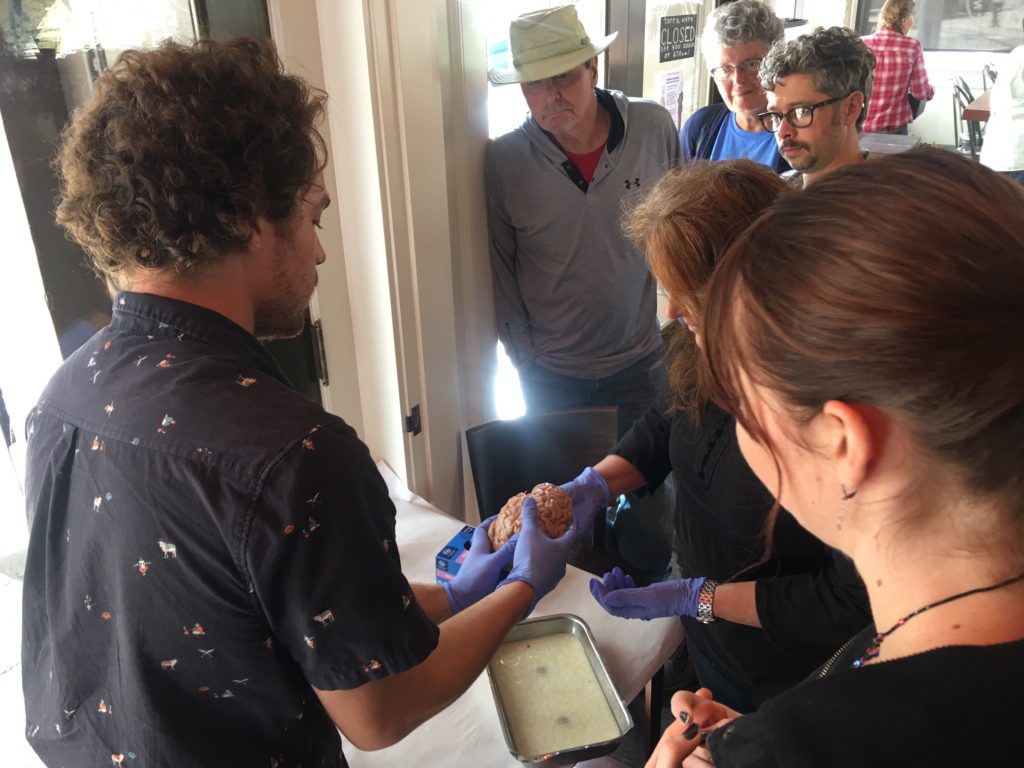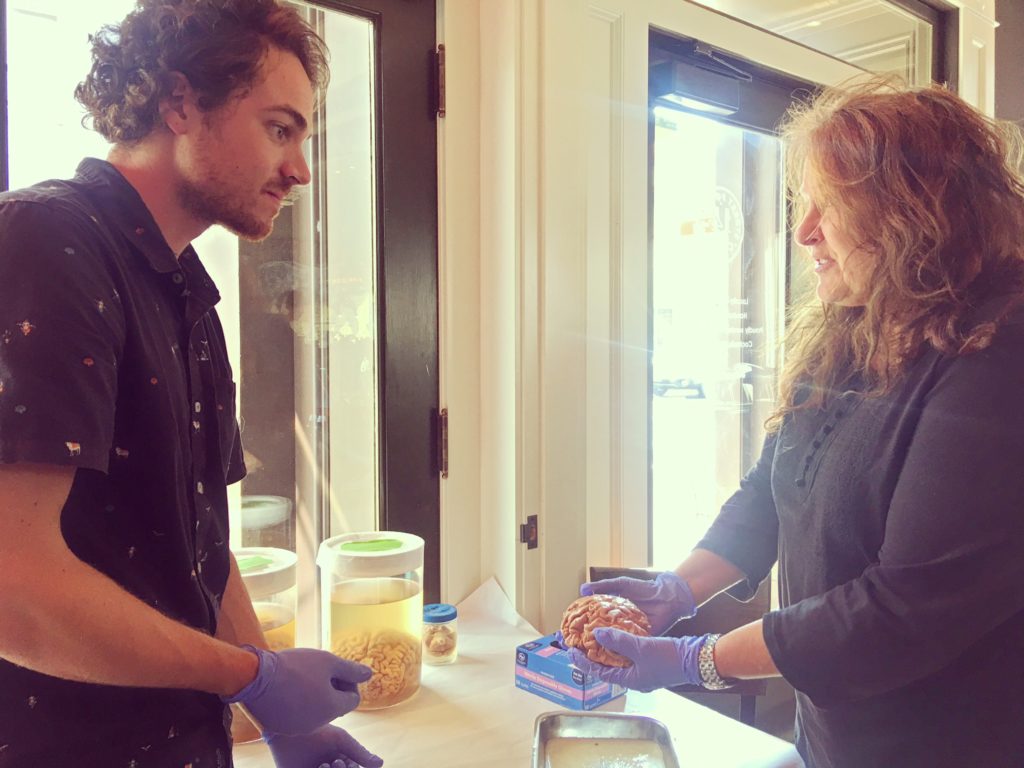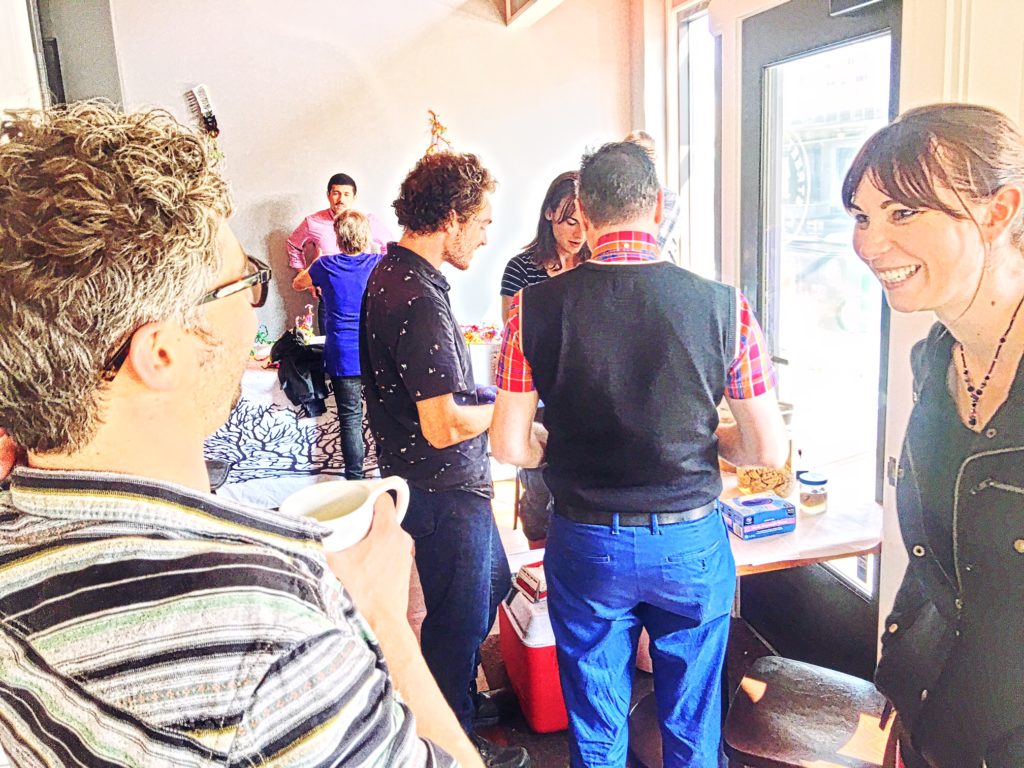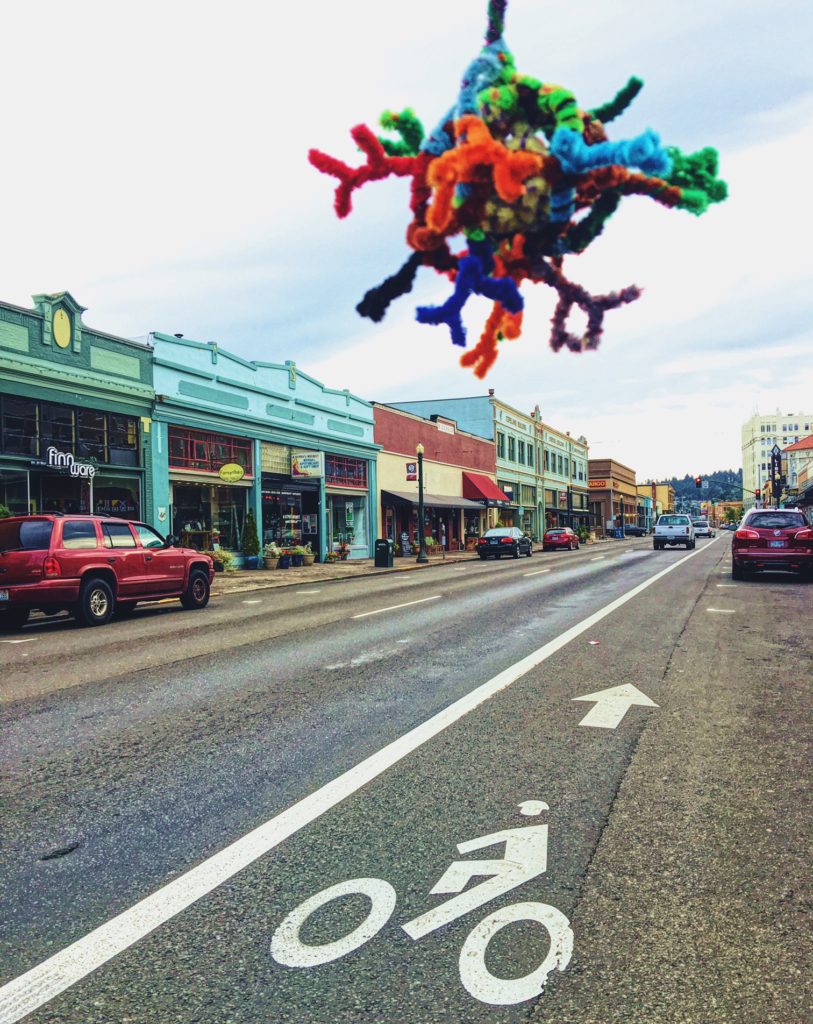This week NW Noggin visited historic Astoria, at the mouth of the Columbia River, to explore some fascinating links between two local favorites – caffeine and alcohol – and the combined actions and effects of these popular drugs on human and rodent behavior and brains…
“Green Douglas firs where the waters cut through
Down her wild mountains and canyons she flew
Canadian Northwest to the oceans so blue
Roll on Columbia, roll on”
-Woody Guthrie

“East at Sunset,” watercolor by Noel Thomas
With Northwest skies still yellow with smoke and speckled ash from raging fires in the Columbia Gorge, we were thrilled by clouds and sprinkles of rain in our Coast Range forests, as we threaded our way west along Highway 30 towards the Pacific…
Alfredo Zuñiga, a graduate student in Behavioral Neuroscience at OHSU in Andre Ryabinin’s lab, was excited to speak about his own research on the interaction of psychoactive ingredients in some terrific brews. In addition, we welcomed accomplished photographer Kim Engeln, also at OHSU, who works with William Birdsong in John Williams opioid tolerance lab, and with biologist Suzy Renn at Reed College. They were joined by Jacob Schoen, a Portland State University undergraduate who studies alcohol and nicotine in Matthew Ford’s lab at the Oregon National Primate Research Center…
Jacob is also the Noggin Resource Council member for PSU, and our official art preparator for exhibits. He’s installed eye-catching pipe cleaner brain cell networks in the Portland Art Museum, at D.C.’s Phillips Collection, at the popular Velo Cult bike shop/pub and in the Psychology office at PSU, and he quickly began transforming the unique space at Street 14 Cafe, which won for Best Coffee and Customer Service in the most recent Readers’ Choice Awards tallied by Astoria’s Coast Weekend…
Alfredo and Kim had collaborated on a similar presentation last spring, at Portland’s Velo Cult…
LEARN MORE: Drunk mice on espresso – what could go wrong?
However, this time Alfredo had new data on the interaction of your Stumptown americano and a Buoy Dunkel, Fort George Vortex IPA, Wet Dog Poop Deck Porter, and/or Reach Break limited edition Vineyard Stout…
Alfredo began by asking his audience of apparently avid coffee and beer/wine/cider/whisky aficionados to consider these two paintings by Pablo Picasso…
On the left is “The Absinthe Drinker,” an early work from 1901, and on the right is “La Cafetière,” or “The Coffee Pot,” from 1944. Absinthe, known as the “Green Fairy,” was closely linked with artists and writers in late 19th and early 20th century Europe, and opposed by the era’s social conservatives. The woman appears isolated, and lost, trying to support herself with her oversized left hand, more in line with the latter view. Absinthe was initially alleged to have hallucinogenic effects, too, though its active ingredient is alcohol, or ethanol; the same as what you find in any of the beverages available from the craft breweries, distillery and new cidery in this well-stocked town. Chemicals added to enhance the bright color may have contributed to the Green Fairy’s reportedly noxious effects…
According to Alfredo, who cited statistics from the National Institute of Alcohol Abuse and Alcoholism, moderate social drinking offers health benefits for many adults. However, excessive drinking manages to kill 88,000 Americans annually, and exacts a $249 billion dollar economic cost…
LEARN MORE: Alcohol & Your Health
LEARN MORE: What’s a “drink..?” At the Newmark for beer & brains
Picasso’s coffee pot, of course, appears entirely enticing and inviting! Caffeine, explained Alfredo, is exceptionally desirable – in fact, it is the most popular drug in the world. According to a 2011 survey by corporate dealer Dunkin Donuts, scientists and lab technicians regularly top the list of professions with the highest proportion of workers “who need coffee to get through the day…”
LEARN MORE: SURVEY REVEALS WHICH PROFESSIONS NEED COFFEE THE MOST
LEARN MORE: Caffeine (from Medline Plus)
LEARN MORE: Coffee: The demon drink?
However, people often mix their caffeinated beverages with alcohol. Examples include the Spanish coffee at Huber’s, an Irish coffee at Kell’s, a Red Bull and vodka at Splash Bar, or an original Four Loko from a Plaid Pantry. Street 14 whipped up some rather delicious combinations as well!
Does this mix of chemicals impact our drinking behavior in measurable ways? Where does caffeine act in the brain, and how might this action account for any observed changes?
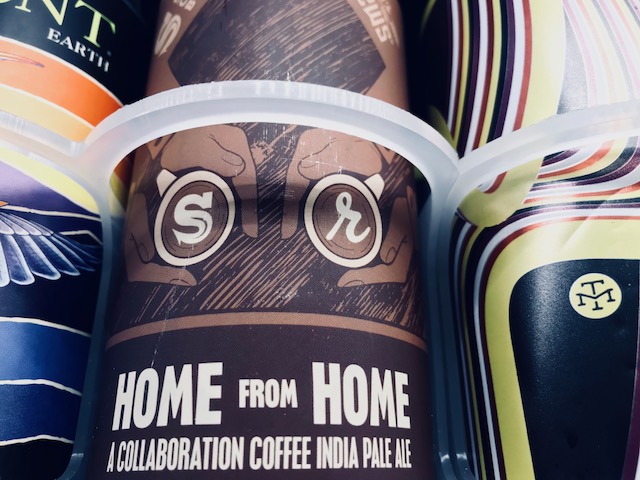
LEARN MORE: English Abbey’s Caffeinated Wine Gains Popularity and Scrutiny
Caffeine is produced naturally by plants, noted Alfredo, including coffee, tea, yerba mate and guarana. It is toxic to some insects, and can contaminate surrounding soils, making it tough for other plants to grow. It also offers an arousing, memory enhancing buzz to bees, increasing pollination!
LEARN MORE: Caffeinated forage tricks honeybees into increasing foraging and recruitment
Caffeine is consumed orally (through the mouth), typically in a delicious beverage like coffee, or tea…
It is metabolized (broken down) by enzymes in the liver, and has a half life of about 3 – 7 hours…
So once it becomes “bioavailable,” and is swirling around your brain for hours after that cup (or two), where does this popular chemical act? Which specific protein receptors does it target, and how does it alter their structure and impact their usual activity, leading to a more alert and functional state..?
Caffeine, a chemical, acts to block (or “antagonize”) receptors for adenosine, a chemical that binds to the adenosine receptors. This reduces the release of some important neurotransmitters, among them dopamine, norepinephrine, serotonin and acetylcholine that are essential for staying alert and awake. Adenosine is a nucleotide (found in DNA, mRNA), and is also part of an important energy substrate known as ATP, or adenosine tri-phosphate…
As your day progresses, and you express your genes and use up ATP, your bloodstream levels of adenosine rise, and bind to adenosine receptors in several cerebral regions, including an area beneath the frontal cortex called the basal forebrain. This decreases brain activity and you feel sleepy, and cognitively a little slow – appropriately ready, of course, for a restorative nap…
But then Kat, Olivia or Micha serve you a glorious and rewarding cup of Stumptown at Street 14, and the caffeine finds your brain’s adenosine receptors, displacing that downer adenosine and transiently attaching itself to the receptors instead. Caffeine blocks the normal response of these receptors, so again, it is considered an adenosine receptor antagonist…
There remain copious swarms of adenosine molecules circulating in your blood, and your body still needs that rest, but your brain is no longer listening to this chemical signal with caffeine antagonizing the receptors in the basal forebrain and elsewhere where adenosine would normally act. You’re up!
LEARN MORE: Caffeine and adenosine
Many audience members had heard of dopamine (DA), a neurotransmitter released in the brain in response to stimuli that predict the delivery of some reward. Dopamine release provokes motivating, anticipatory behavior, that we (and rats) tend to enjoy. Dopamine acts at its own DA receptors, but remarkably these DA receptors can form larger structural associations with receptors for other chemicals, including adenosine…
When receptors for two entirely different chemicals link together into a larger structure, it’s called a heteromer, and DA/adenosine heteromeric receptor complexes have been identified in dopamine pathways associated with reward. As your adenosine levels rise, adenosine binds to these heteromeric receptors, decreasing their response to dopamine…
So as you get fatigued, it’s harder to get motivated to continue. It’s time for bed!
LEARN MORE: Heteromeric Dopamine Receptor Signaling Complexes: Emerging Neurobiology and Disease Relevance
LEARN MORE: An Update on Adenosine A2A-Dopamine D2 receptor interactions
But caffeine, of course, blocks adenosine’s action – it prevents it from binding to its receptor – and may therefore help maintain more dopamine response.
In fact, regular coffee consumption appears to increase the number of dopamine receptors in reward pathways in the brain! So caffeine can keep you awake, and going, and motivated to respond and engage further…
LEARN MORE: Caffeine increases striatal dopamine D2/D3 receptor availability in the human brain
Now alcohol, of course, is both motivating – and, it turns, out, it increases the available amount of adenosine. So that delicious Painted Lady gin in Dulcye’s drink (named in honor of Astoria Downtown Historic District Association President Dulcye Taylor) will raise adenosine levels in your brain, and as you keep drinking, you’ll feel drowsy…
Alcohol is considered somnogenic – or “sleep generating” – and too much ultimately leads to ataxia. In other words, it makes you uncoordinated in your movements, slurs your speech, and makes you a significant danger if you try to operate heavy machinery, like a car…
LEARN MORE: Acute effects of alcohol on the human brain: a resting-state fMRI study
So this increased adenosine from alcohol is likely beneficial, helping you slow your drinking and get some needed rest. As Alfredo described it, adenosine may be acting as a helpful “brake…”
But then you add the Red Bull, or the after dinner espresso, and all of a sudden it’s brakes off!
Caffeinated alcoholic beverages have certainly been popular for a long, long time, but few diners at Street 14 pound multiple Dulcye’s drinks. In contrast, beverages like the short-lived original Four Loko reportedly led to “mass hospitalizations,” and caffeine was ultimately removed from these drinks under orders from the Food and Drug Administration…
LEARN MORE: FDA on Caffeinated Alcoholic Beverages
LEARN MORE: Alcohol and Caffeine: The Perfect Storm
LEARN MORE: The Four-Loko Effect
Alfredo has discovered that for his rodent subjects, much like people, caffeine is certainly rewarding at low doses, but becomes more unpleasant when the dosage is high…
He uses a behavioral task known as conditioned place preference, where his mice are given the choice of spending time in either of two attached chambers, each with a distinctive floor texture and other distinguishable environmental stimuli. One chamber (G+) is consistently paired with delivery of caffeine, and again at low doses this leads mice to hang out there more…
IMAGE ABOVE: Our very own G+ chamber 🙂
However, Alfredo has also discovered that a high dose of caffeine, while aversive on its own, becomes very desirable when paired with alcohol! Mice will gladly spend the most time in chambers previously associated with high doses of Irish or Spanish coffee, as opposed to coffee alone…
Kim Engeln then took the stage to describe her photographs!
From Kim: “When I was asked to create an artistic piece to complement Alfredo’s research, I knew I wanted to use my favorite medium: photography. I thought of Charles Darwin and his book “On the Expression of Emotions in Man and Animals” and wanted to capture the humorous and truthful aspects of facial expressions seen in his own photography experiments…
LEARN MORE: On the Expression of Emotions in Man and Animals
It was really easy finding volunteers for this project – all it took was an invitation to brunch served with free coffee and alcohol! I encouraged the audience to try to guess which portraits were taken right after drinking a pot of coffee, which photos were of us mixing coffee and alcohol, and which photos showed us with only booze left in our system…
The drunken photos were easier to identify – our droopy eyes, messy hair, and wild expressions (especially Allie’s!) gave it away. However there was quite a bit of disagreement over the coffee only photos, and the coffee and alcohol photos. Some thought the big smiles on our faces were from the caffeine, while others thought the alcohol was the contributor. Personally, I think it was the eyes that gave it away as I noticed how our eyelids tended to droop more and more as the ethanol in our bloodstreams rose, and the caffeine faded. I had a lot of fun with this project and I wanted the viewers of my photographs to get a sense of the fun and laughter my friends and I shared during our brunch. I got a chance to meet all sorts of community members, and I think everyone had a great time exchanging laughs and conversing about art and science over coffee and mixed drinks!”
Visitors to Street 14 enjoyed asking questions of young researchers, and considering alcohol and caffeine actions on their own brains while holding and examining real human cerebrums, thanks to Noggin donations from two generous Northwest supporters of cool science communication and outreach, BioGift and Medcure…
Our sincere thanks to Jennifer and Micha Cameron-Lattek for inviting brains and art into their award-winner Street 14 Cafe, and to Astoria, a unique city we are certainly conditioned to prefer as a welcoming, distinctive and creative place (G+!)…
LEARN MORE: Totem pole in Astoria no monkey business




